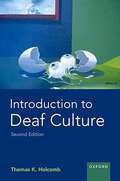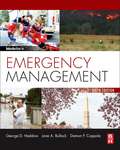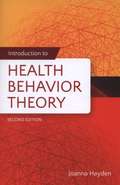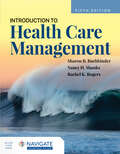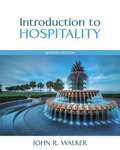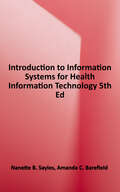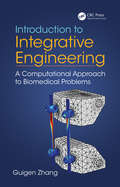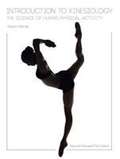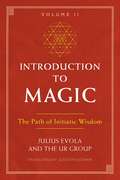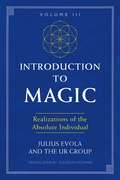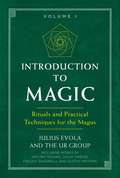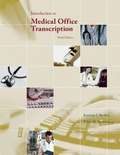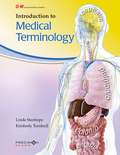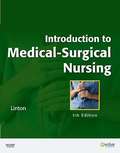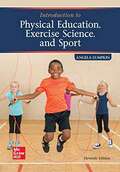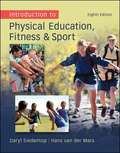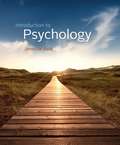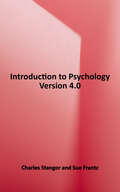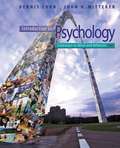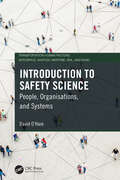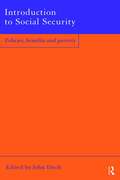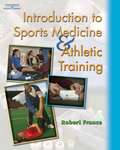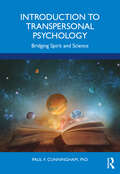- Table View
- List View
Introduction to Computer Systems for Health Information Technology (Second Edition)
by Nanette B. Sayles Kathy C. TrawickThe objectives of this book are: Describe the functions of the basic components of the personal computer to include hardware, software, networks, and Internet technologies; Identify and discuss the impact of computers in healthcare in all areas within a facility; Discuss the history of computers in healthcare; Compare and contrast the similarities and differences between the Internet, intranet, and extranet as used in healthcare.
Introduction to Deaf Culture (PROFESSIONAL PERSPECTIVES ON DEAFNESS: EVIDENCE AND APPLICATIONS)
by Thomas K. HolcombThomas K. Holcomb's highly successful textbook on Deaf culture has been fully revised and updated in this second edition. The changes reflect those in the field and include three new chapters focusing on the impact of technology on the Deaf experience, the roles of allies in supporting the Deaf community, and the diversity that exists in the Deaf community. Also new to this edition is an ASL summary of each chapter, making the book accessible in two languages that are important in the Deaf community, ASL and English. The book provides a broad yet in-depth exploration of how Deaf people are best understood from a cultural perspective. It explores the tension between the Deaf and disabled communities, the cultural norms of the Deaf community, Deaf art and literature, the solutions being offered by the medical and Deaf communities for effective living as Deaf individuals, and an analysis of the universality of the Deaf experience. As a member of a multigenerational Deaf family with a lifetime of experience living bi-culturally among Deaf and hearing people, author Thomas K. Holcomb enhances the academic discussions with engaging stories and the poetry and art of Deaf individuals. In addition to being used in college-level courses, this book can also help parents and educators of Deaf children understand the world of Deaf culture. It offers a beautiful introduction to the ways Deaf people effectively manage their lives in a world full of people who hear.
Introduction to Emergency Management (6th Edition)
by Damon P. Coppola Jane A. Bullock George D. HaddowIntroduction to Emergency Management sets the standard for excellence in the field and has educated a generation of emergency managers. Haddow, Bullock, and Coppola return for the sixth edition with an emphasis on climate change as a major hazard. Fully updated throughout for new regulations and workflows, with new case studies covering the latest in best practices, this classic textbook prepares students for the challenges of a career in emergency management. Expanded information on disaster recovery coordination structures; Emphasis on climate change as a key hazard faced by disaster managers; Coverage of social media as critical tool in emergency management; Fully updated throughout for the latest regulations and workflows; New examples and case studies throughout; Updated ancillaries to keep course instruction fresh.
Introduction to Health Behavior Theory (Second Edition)
by Joanna Aboyoun HaydenIntroduction to Health Behavior Theory, Second Edition is designed to provide students with an easy to understand, interesting, and engaging introduction to the theoretical basis of health education. Written with the undergraduate in mind, the text uses comprehensive and accessible explanations to help students understand what theory is, how theories are developed, and what factors influence health behavior theory. Covering the more frequently used health behavior theories, the author breaks each theory into concepts and constructs to enhance comprehension and encourage students to discover how these theories can be put into practice. New to the Second Edition:* Data, information, and illustrations updated throughout, including the new "My Plate"* A new Theory in Action article and new classroom activities in each theory chapter* New and revised chapters on Social Ecological Models and Social Capital Theory
Introduction to Health Care Management
by Rachel Rogers Sharon B. Buchbinder Nancy H. ShanksCovering a range of healthcare settings, Introduction to Health Care Management, Fifth Edition provides a solid orientation to management in the health care discipline. Written for students just entering the field, this reader friendly text is filled with examples designed to engage the reader’s imagination, while addressing the important issues in healthcare management, such as ethics, cost management, strategic planning and marketing, information technology, human resources, and more. The new Fifth Edition integrates population health and information management throughout and offers new coverage of artificial intelligence (AI), the impact of COVID 19, and concepts and issues of diversity, equity, and inclusion (DEI). Many of the cases and exercises are new or significantly updated to reflect current healthcare management challenges, while research resources and references have been updated throughout.
Introduction to Hospitality (Seventh Edition)
by John R. WalkerPrepares students to succeed in any area of the hospitality industry. Introduction to Hospitality, 7/e, focuses on hospitality operations while offering a broad, comprehensive view of the world’s largest industry. The text is organized into four sections: hospitality and lodging; beverages, restaurants, and managed services; tourism, recreation, attractions, clubs, and gaming; and assemblies, events, attractions, leadership, and management. Each section includes real-world profiles, first-hand accounts, and engaging case studies to help readers connect with the material and foster an appreciation of the industry’s unique enthusiasm and passion. New photos, page layouts, and hands-on examples help students understand the how-to aspects of today’s hospitality industry. Updated to reflect today’s trends and realities, the Seventh Edition contains new coverage of spas, updated and new corporate profiles, salary information, hospitality-related technologies, and more!
Introduction to Information Systems for Health Information Technology, 5th Edition
by Nanette B. Sayles Amanda C. BarefieldHealth information management (HIM) students and professionals must learn everything they can about the basics of electronic health records (EHRs), general healthcare computer systems, data retrieval, and other EHR system topics. This text helps readers gain an understanding of how these systems and issues affect, and are affected by, the HIM profession. Updated to reflect current information technology (IT) content in the healthcare environment relevant to both scholars and professionals, this fifth edition of Introduction to Information Systems for Health Information Technology explains the growing wealth of health data and information available to HIM practitioners and what it can do for patients and society, while also explaining the responsibility to secure these assets. This edition emphasizes practical applications within the HIM profession, offering revised real-world scenarios and practice opportunities. Key Features: - New online student workbook - Real-World Cases and Check Your Understanding questions in each chapter - Updated privacy and security information and best practices
Introduction to Integrative Engineering: A Computational Approach to Biomedical Problems
by Guigen ZhangThis textbook is designed for an introductory course at undergraduate and graduate levels for bioengineering students. It provides a systematic way of examining bioengineering problems in a multidisciplinary computational approach. The book introduces basic concepts of multidiscipline-based computational modeling methods, provides detailed step-by-step techniques to build a model with consideration of underlying multiphysics, and discusses many important aspects of a modeling approach including results interpretation, validation, and assessment.
Introduction to Kinesiology: Studying Physical Activity (3rd edition )
by Shirl J. HoffmanThis introductory text orients students to the discipline of kinesiology and its relationship to physical activity, and gives students an overview of different careers in the field, including health and fitness, therapeutic exercise, teaching physical education, coaching and sport instruction, and sport management. Each career chapter offers a brief historical background, and details on work settings, educational qualifications, case studies, and profiles of working professionals. Learning features include chapter objectives and study questions, in a color layout with color photos. This third edition has been rewritten to make material more accessible to undergraduate students who may not have in-depth background. Also new to this edition is an online study guide, with multimedia activities, review quizzes, and web exercises. Hoffman is professor emeritus of exercise and sport science at the University of North Carolina-Greensboro.
Introduction to Kinesiology: The Science of Human Physical Activity
by Mitchell MarilynIntroduction to Kinesiology: The Science of Human Physical Activity outlines the major concepts, principles, and experimental findings for the curious yet serious student interested in the field of kinesiology. Like most fields of science, it is important to provide kinesiology students with a textbook that covers the historical development of the field, discusses career opportunities, and provides the groundwork for future coursework. It is also important to clearly articulate the limit and scope of kinesiology by defining core knowledge and to emphasize the cross-disciplinary nature of kinesiology. Introduction to Kinesiology was designed to meet all of these requirements.
Introduction to Magic, Volume II: The Path of Initiatic Wisdom
by Julius Evola The UR GroupAuthentic initiatic practices, rituals, and wisdom collected by the UR Group • Shares a rigorous selection of initiatory exercises, including instructions for creating the diaphanous body of the Opus magicum, establishing initiatic consciousness after death, and the construction of magical chains (the enchained awareness of initiates) • Offers studies of mystery traditions throughout history, presenting not only the principles themselves but also witnesses to them and their continual validity today The “Gruppo di UR” was a group of Italian esotericists who collaborated from 1927 to 1929. The purpose of this group was to study and practice ancient rituals gleaned from the mystery traditions of the world, both East and West, in order to attain a state of superhuman consciousness and power to allow them to act magically on the world. They produced a monthly journal containing techniques for spiritual realization, accounts of personal experiences, translations of ancient texts, and original essays on esoteric topics. The group included a distinguished line-up of occultists, neo-pagans, freemasons, Anthroposophists, orientalists, poets, and members of high society. The prime movers of the group were Arturo Reghini (1878-1946), a Pythagorean mathematician and reviver of a spiritual Freemasonry, and Julius Evola (1898-1974), then a young philosopher with a precocious mastery of the esoteric doctrines of East and West. Many years later, in 1971, Evola gathered these essays into three volumes. Inner Traditions published Volume I in 2001, under the title Introduction to Magic: Rituals and Practical Techniques for the Magus. This volume, the second in the series, complements the first one, yet they are not strictly sequential, and their contents can be read in any order. Volume II shares authentic initiatic wisdom and a rigorous selection of initiatory exercises, including instructions for creating the diaphanous body of the Opus magicum, establishing initiatic consciousness after death, and the construction of magical chains (the enchained awareness of initiates). It offers studies of mystery traditions throughout history, presenting not only the principles themselves but also witnesses to them and their continual validity today. This series shows that the “Magic” of the UR Group meant an active and affirmative attitude toward individual development, handed down from a “primordial tradition” and discernable in alchemy, Hermetism, esoteric religious doctrines, indigenous practices, Tantra, Taoism, Buddhism, Vedanta, and the pagan mysteries of the West. Although some of the practical experiments demanded extraordinary efforts, both individual and collective, there is incalculable value here even for the less heroic, for merely reading these essays leaves a permanent mark on the reader.
Introduction to Magic, Volume III: Realizations of the Absolute Individual
by Julius Evola The UR Group• Explores esoteric practices for individual development, handed down from a primordial tradition and discernable in alchemy, Hermetism, religious doctrines, Tantra, Taoism, Buddhism, Vedanta, and the pagan mysteries of the West • Reveals the ultimate magical goal of the &“Absolute Individual,&” the immortal and divine potential that requires rare gifts and extraordinary efforts for its realization This volume, the third in the series, complements the first two, yet they are not strictly sequential, and their contents can be read in any order. Volume III, more than the others, bears the personal stamp of Julius Evola. In its pages you&’ll discover that the &“magic&” of the UR Group has nothing to do with sorcery or superstition. It was their term for an active and affirmative attitude toward individual development handed down from a &“primordial tradition&” and discernible in alchemy, Hermetism, esoteric religious doctrines, indigenous practices, Tantra, Taoism, Buddhism, Vedanta, and the pagan mysteries of the West. Its goal was the &“Absolute Individual,&” the immortal and divine potential that requires rare gifts and extraordinary efforts for its realization. However, there is incalculable value in this volume even for the less heroic. By studying the practices and realizations within, the reader will be liberated from conventional dogmas--religious, political, scientific, and psychological--and see with the clearer eye of realization.
Introduction to Magic: Rituals and Practical Techniques for the Magus
by Julius Evola The UR GroupThe rites, practices, and texts collected by the mysterious UR group for the use of aspiring mages. • Rare Hermetic texts published in English for the first time. • Includes instructions for developing psychic and magical powers. In 1927 Julius Evola and other leading Italian intellectuals formed the mysterious UR group. Their goal: to bring their individual egos into a state of superhuman power and awareness in which they could act "magically" on the world. Their methods: the practice of ancient Tantric and Buddhist rituals and the study of rare Hermetic texts. So successful were they that rumors spread throughout Italy of the group's power, and Mussolini himself became quite fearful of them. Now for the first time in English Introduction to Magic collects the rites, practices, and knowledge of the UR group for the use of aspiring mages. Included in Introduction to Magic are instructions for creating an etheric double, speaking words of power, using fragrances, interacting with entities, and creating a "magical chain." Among the arcane texts translated are the Tibetan teachings of the Thunderbolt Diamond Path, the Mithraic mystery cult's "Grand Papyrus of Paris," and the Greco-Egyptian magical text De Mysteriis. Anyone who has exhausted the possibilities of the mundane world and is ready to take the steps necessary to purify the soul in the light of knowledge and the fire of dedication will find a number of expert mentors here.
Introduction to Medical Office Transcription (3rd Edition)
by Karonne J. Becklin Edith M. SunnarborgAn introduction into teaching medical transcription, this workbook reviews anatomy, medical terminology, symptoms, disease conditions, and grammar as it relates to the field.
Introduction to Medical Terminology
by Linda Stanhope Kimberly TurnbullAs one of the first Medical Terminology textbook programs developed specifically for the high school classroom, Introduction to Medical Terminology will invite you into the language of medicine. Through comprehensive coverage, masterful illustrations, and a wealth of engaging activities, you will explore, learn about, and use medical word parts vital to a career in the healthcare industry.
Introduction to Medical-Surgical Nursing (Fifth Edition)
by Adrianne Dill LintonWith just the right level of information to equip you to effectively care for adults and older adults, Linton''s Introduction to Medical-Surgical Nursing, 5th Edition is the leading LPN/LVN text in its field. Covering both med-surg and psychiatric mental health conditions and disorders, it addresses your role in a variety of care settings, emphasizes culturally competent care and holistic nursing, and thoroughly covers all relevant NCLEX-PN Test Plan content. Abundant real-life case studies clearly show how to apply what you''ve learned to clinical practice. Features separate chapters on common, high-profile disorders (including hypertension, diabetes, and shock), providing an in-depth understanding for patient care. Offers foundational units on basic concepts related to the health care system, care settings, the nursing process, leadership, nutrition, the older adult, growth and nutrition, legal/ethical considerations, evidence-based nursing care, and many more essential topics, avoiding repetition later in the text Includes a separate, comprehensive unit on the older adult and related disorders - no other LPN/LVN med-surg text has as much coverage of this primary patient group. Includes a separate, comprehensive unit on psychosocial responses to illness, psychiatric disorders, and substance abuse - eliminating the need for a separate psychiatric mental health nursing text. Emphasizes content related to the NCLEX-PN Test Plan, including health promotion, nutrition, legal/ethical issues, HIPAA, and prevention of medication/medical errors. Offers in-depth pharmacology coverage: the Pharmacology Tutorial covers drug classifications, how drugs work, and nursing responsibilities; Pharmacology Capsules boxes provide medication information, precautions for use, interactions, and side/adverse effects; and Pharmacology and Medications tables in body systems chapters include classification, use/action, side/adverse effects, and nursing interventions - all with the goal of reducing medication errors on the job and equipping you to pass the NCLEX exam. Assists with assignment and supervision, helping you assign tasks to nurse assistants, patient care techs, and unlicensed assistive personnel, and making sure you understand the difference between delegation, management, supervision, and assignment of tasks on the health care team. Features Diagnostic Tests and Procedures tables for a quick reference to MRI, CT, Doppler flow, lumbar puncture tests for neurologic disorders, and much more. Highlights timely information with Health Promotion boxes, Cultural Considerations boxes, Nutrition Considerations boxes, and Complementary and Alternative Therapies boxes. Provides bulleted lists of nursing instructions for Patient Teaching Plans, stressing the role and responsibility of the LPN/LVN to reinforce patient education. Provides consistent Nursing Care Plans that reinforce the nursing process and focus on critical thinking, and Put on Your Thinking Cap Critical Thinking boxes encourage you to pause and consider the practical implications of what you have just read. Highlights safety and risk factors with a new Safety Considerations icon, alerting you to potential risks in the clinical setting. Emphasizes evidence-based practice, providing specific examples of how scientific evidence can justify and support patient care. Offers a unique focus on prioritization throughout, with top priorities for each major disorder emphasized in all nursing care sections, to help you better prepare for the NCLEX exam. Get Ready for the NCLEX-PN Examination! includes Key Points, Review Questions, and Case Studies that address the NCLEX Client Needs categories of Safe and Effective Care Environment, Physiological Integrity, Psychosocial Integrity, and Health Promotion and Maintenance. An excellent review for course assessments and the NCLEX exam!
Introduction to Physical Education, Exercise Science, and Sport
by Angela LumpkinIntroduction to Physical Education, Exercise Science, and Sport explores the exciting diversity of physical education, exercise science, and sport, and examines the breadth of potential careers available in these multifaceted fields. Students are introduced to the heritage, current programs, and future potential of these rapidly expanding areas. The text delves into practical suggestions, including how to create resumes and how to help students prepare for careers in physical education and exercise science in diverse settings. Written in a conversational and personal style, the text is designed for students enrolled in their first course related to the field.
Introduction to Physical Education, Fitness and Sport
by Daryl Siedentop Hans Van Der MarsAuthored by two leading experts in the field, the new eighth edition of Introduction to Physical Education, Fitness and Sport introduces readers to the history and philosophies underlying today's professions while focusing on current trends and issues facing school Physical Education, fitness and sport. Specifically, the authors introduce readers to the professions' key concepts, programming approaches, standards and expectations, as well as the problems and issues. As the United States seeks to reverse trends in overweight and obesity, readers will learn how these three professions have a central responsibility in creating an environment that supports, encourages and promotes physical activity for all people.
Introduction to Psychology (Tenth Edition)
by James W. KalatJames Kalat's best-selling INTRODUCTION TO PSYCHOLOGY does far more than cover major theories and studies; it encourages you to question the information and ask yourself, "How was this conclusion reached?" and "Does the evidence really support it?" In this student-praised text, Kalat challenges your preconceptions about psychology to help you become a more informed consumer of information not only during your college experience but also as you venture into your post-college life. With his humorous writing style and hands-on "Try It Yourself" exercises, Kalat puts you at ease and gets you involved with what you are studying so that you can succeed in your course.
Introduction to Psychology Version 4.0
by Charles Stangor Sue FrantzIntroduction to Psychology is a concise and conceptual introduction to the fascinating subject of psychology. This new version welcomes a co-author, Sue Frantz, who has worked with a diversity of students over the years. As a result, Sue contributes many fresh, classroom-based insights to enliven the text and bring it fully up to date. The core premises of this book remain constant, however. Featuring a central theme of action—predicting our actions and those around us—the narrative grabs students’ attention and does not let go. A strong underlying secondary theme of empiricism unifies the narrative under the umbrella of psychology as a science. Its standard, fourteen-chapter organization makes this textbook an ideal choice for either a typical semester- or quarter-long course.
Introduction to Psychology: Gateways to Mind and Behavior (Thirteenth Edition)
by Dennis Coon John O. MittererCo-written by an author who garners more accolades and rave reviews from instructors and students with each succeeding edition, INTRODUCTION TO PSYCHOLOGY: GATEWAYS TO MIND AND BEHAVIOR, THIRTEENTH EDITION attracts and holds the attention of even difficult-to-reach students. The Thirteenth Edition's hallmark continues to be its pioneering integration of the proven-effective SQ4R learning system (Survey, Question, Read, Reflect, Review, Recite), which promotes critical thinking as it guides students step-by-step to an understanding of psychology's broad concepts and diversity of topics. Throughout every chapter, these active learning tools, together with the book's example-laced writing style, discussions of positive psychology, cutting-edge coverage of the field's new research findings, and excellent media resources, ensure that users find the study of psychology fascinating, relevant, and above all, accessible.
Introduction to Safety Science: People, Organisations, and Systems (Transportation Human Factors)
by David Peter O'HareThe book is designed as an accessible and readable introduction to a rapidly expanding area that is in demand worldwide. A variety of professionals from different backgrounds are being tasked with managing health and safety risks in a wide variety of settings. Many lack current and up-to-date knowledge of the key developments that have taken place in Safety Science in recent decades, as well as a sense of how these developments fit in with previous approaches. This book takes readers on a ‘journey’ across three broad developments in safety science. It covers topics that focus on the individual including human error, risk and the role of cognition in human performance. It then shifts to research in safety science that uses organizations as the basic unit of analysis, questions about organizational decision making and the characteristics that dispose towards or against organizational failure and it introduces perspectives based on systems science that address issues that arise out of complexity and interdependence. Those who will purchase this book are students taking courses in human factors, ergonomics, applied psychology, occupational health and safety management. Professionals working in safety management in any field from agriculture, construction, shipping, aviation, power generation, oil exploration, manufacturing to healthcare will find this book useful, as well as general readers interested in why systems fail.
Introduction to Social Security: Policies, Benefits and Poverty
by John DitchSocial Security forms a major area of government policy and social expenditure. Government activity in this area impacts directly on all citizens, and consequently social security policy is the focus for much debate. People are affected by social security whether by funding it through taxation, or using it when claiming unemployment or other benefits. Introduction to Social Security is an up-to-date text on this important and complex social policy issue. It provides a second introduction for students of social policy and administration and includes contributions from some of the best known and most respected names in the field.
Introduction to Sports Medicine and Athletic Training
by Robert C. FranceIntroduction to Sports Medicine & Athletic Training is a book written for individuals interested in athletics and the medical needs of athletes. This book is unique in that it covers four distinct disciplines in an easy to understand format. The four disciplines covered include: Sports Medicine, Athletic Training, Anatomy, and Physiology. This all-in-one resource allows the individual to grasp the concepts of anatomy and physiology, and then apply them to Sports Medicine and Athletic Training. Each discipline is fully presented, and uniquely sequenced together to give the user a full understanding of this exciting field. There are comprehensive chapters on nutrition and sports psychology. Instructors will enjoy the depth of the material covered and the ease in which it is presented. Introduction to Sports Medicine & Athletic Training is the first full-concept book ever written that an entire course can be created around.
Introduction to Transpersonal Psychology: Bridging Spirit and Science
by Paul F. Cunningham, Ph.D.Introduction to Transpersonal Psychology: Bridging Spirit and Science provides an accessible and engaging introduction to this complex and evolving field. Adopting a modular approach, the book systematically relates key themes of Transpersonal Psychology to three major areas within psychology: general psychology, experimental psychology, and clinical psychology. Covering a wide range of topics including transpersonal states of consciousness, biological foundations, research methods, and cognition, the book also features extensive discussion of transpersonal theorists and the impact of their work on our understanding of psychological concepts. The book also introduces contemporary developments in the field and anticipates future advances such as feminist perspectives and cross-cultural approaches alongside practical experiments designed to give transpersonal theories and concepts psychological roots. A critical evaluation of both mainstream and transpersonal theories and research is applied throughout to foster analytical skills and encourage critical and scientific thinking about humanity’s nature as spiritual creatures and ways to educate for personal and social transformation. Accompanied by an online instructor’s manual, this book will be an essential companion for all students of Transpersonal or Humanistic Psychology, or those interested in applying transpersonal ideas to mainstream psychological research.

